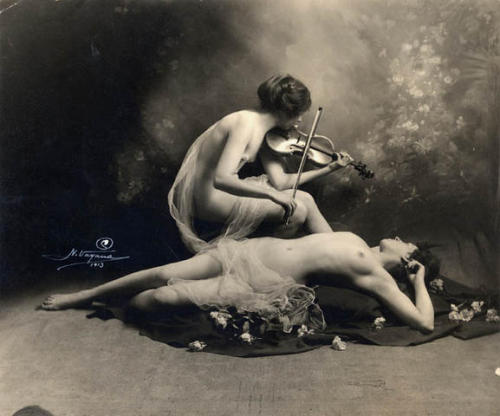cavetocanvas: Leaf From The Memoirs Of An Old Woman - Paul...
Te Faaturuma (Brooding Woman). 1891. Oil on canvas. The...

Te Faaturuma (Brooding Woman). 1891. Oil on canvas. The Worcester Art Museum, Worcester, MA, USA
2headedsnake: brwnpaperbag.com Christian Herr
septagonstudios: Simone Bianchi
Tiepolo - Immaculata (1767-69) Giovanni Battista Tiepolo...

Tiepolo - Immaculata (1767-69)
Giovanni Battista Tiepolo
Immaculata (1767-69)
Madrid Museo del Prado
Photo

necspenecmetu: Ottavio Vannini, Jael and Sisera, early 1640s
Bernard Picart (or Picard) (1673-1733) was a French book...

Bernard Picart (or Picard) (1673-1733) was a French book illustrator and one of the most outstanding engravers in the first decades of the 18th century. His most famous work - see: Designer Religion - was an enormous compendium of the world’s religions.
In ‘Neueröffneter Musen-Tempel’, a collection of mythological fables and stories (most notably from Ovid’s ‘Metamorphoses’) is presented, accompanied by sixty copperplate engravings by Picart. The illustrations are superior in quality, even as they appeared in 1733 in the fading light of the Baroque tradition. The fabulous ornate border patterns lend the compositions something of a formal quality like framed paintings; indeed, Picart drew inspiration for a number of his engravings from mid-17th century works by the Rubens student, Abraham van Diepenbeeck. But the majority of the designs are by Picart himself.
Motives listed for Picart’s illustration include: Alcyone, Alpheus, Andromeda, Apollo, Arethusa, Argonauts, Argus, Aristaeus, Artemis, Calais, Cassandra, Castor, Ceyx, Cycnus, Deucalion, Dioscuri, Echo, Enceladus, Endymion, Eos, Eurynome, Giants, Glaucus, Harpies, Heliades, Hera, Hermaphroditus, Hermes, House of Hypnos, Io, Iphis, Leander, Leucothoe, Lycaon, Memnon, Niobe, Niobids, Oeneus, Palladium, Pan, Perseus, Phaethon, Phineus, Polydeuces, Proteus, Pygmalion, Pyrrha, River Gods, Salmacis, Selene, Semele, Syrinx, Tantalus, The Flood, Tithonus, Trojan War, Troy, Underworld, Zetes, Zeus [source]
‘The Temple of Muses’ was published in France and Germany simultaneously in 1733 and includes captions in English, French, German and Dutch below each illustration. The images above are from a 1754 edition published in Amsterdam.
vanfullersublime: Adam and Eve, artist...

Adam and Eve, artist unidentified
Visit: http://fullerart.tumblr.com or http://www.vanevanfuller.com
The picture can also be reached at:
http://www.galleryshowsonline.com/show/scottexperimentations1210
Artist is Irina Kalyuzhnaya (thanks , Google image search facility).
A Map of the Open Country of a Woman’s Heart was a map created...

A Map of the Open Country of a Woman’s Heart was a map created by D. W. Kellogg circa 1833–1842, in the tradition of these maps of the human conditionyou might recall, subtitled “Exhibiting its internal communications, and the facilities and dangers to Travellers therein.” Though it mostly depicts Woman as a sentimental, selfish, and superficial being driven by vanity, it places Love at the center of her heart, with Good Sense, Patience, and Prudence at its tip — or bottom, depending on the interpretation.
Thanks Alım Erdemir.
necspenecmetu: Giovanni Francesco Barbieri (Il Guercino),...
welovepaintings: Carlos Schwabe The Wave (Study) 1906
revibrahim: The Fool, from the Rumi Tarot Deck.
A lithograph that seems to have first appeared in 1870 (Figuier...

Edited by
A lithograph that seems to have first appeared in 1870 (Figuier 1870), which depicts an Ice Age artist working on the engraving of a plaquette as if it were propped up on an easel. Note that this lithograph was made some nine or more years prior to the “discovery” of the first cave paintings (Altamira, 1879), but during the time when painting was considered the most elevated of the arts.
WOMEN IN HUMAN EVOLUTION
Lori D. Hager (p. 176)
The sweet melancholy of a poem becomes music and dance. The...

The sweet melancholy of a poem becomes music and dance. The music of Carl Maria von Weber (Aufforderung zum Tanz, with orchestration by Hector Berlioz) and choreographed by Mikhail Fokine are masterfully represented in a scene from the Great Nijinsky and Tamara Karsavina. We are in 1911, in Paris at the Théâtre du Châtelet, for the first, exactly on June 6.
turnofthecentury: queering:Nude study,1913 by Nino Vayana
centuriespast: Vedder, ElihuAmerican (1836-1923)Etruscan...

Vedder, Elihu
American (1836-1923)
Etruscan Girl
1868
Collections Database
Five Colleges and Historic Deerfield Museum Consortium
Photo










